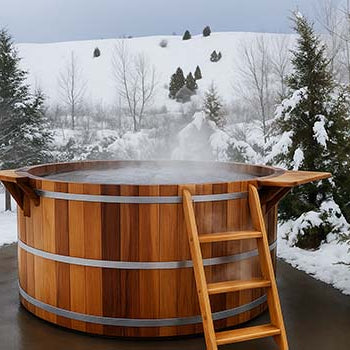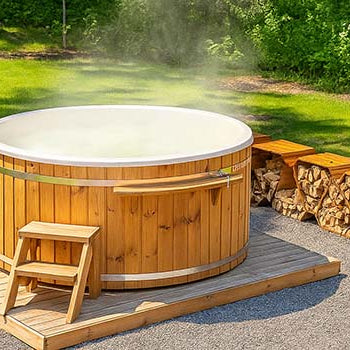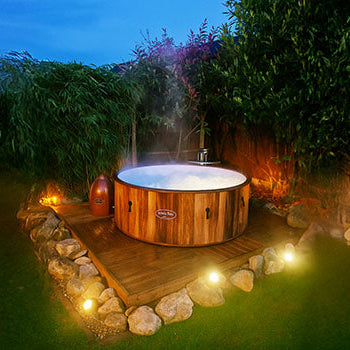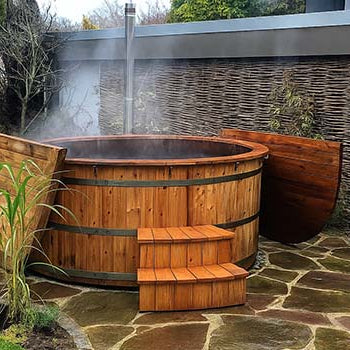Thinking about a hot tub but scared your electricity bill might explode like an overworked kettle?
Short answer: they can be costly, but not if you run them smartly.
Some tubs sip energy like tea (hello, insulated Acrylics), others are more like a teenager on a power binge (looking at you, inflatables).
Rotomoulded tubs offer a budget-friendly balance, and Wooden hot tubs? A charming old-school option that can even skip the electricity altogether.
Ready to uncover the real numbers and clever savings tricks? Let’s dive in.

Understanding Hot Tub Running Costs: What's Included?
Owning a hot tub isn’t just about plopping into bubbles with a glass of wine.
Behind every relaxing soak is a bundle of running costs: electricity, water, chemicals, filters, and the occasional repair job.
Think of it like having a car. You don’t just pay for the car, you fuel it, service it, and sometimes fix that suspicious rattle.
With a hot tub, it’s the same deal, only with more bubbles and fewer traffic jams.
Let’s break down each cost so you know exactly what you’re in for.
Electricity: The Biggest Factor Explained
This is your tub’s biggest appetite.
Heating the water, powering the jets, running the filters, it all adds up.
A typical hot tub uses between 3–7 kWh per day, which translates to around £30–£70 per month, depending on your setup.
If your tub’s poorly insulated or you’re using it daily in winter, expect costs to climb.
But don’t panic. Energy-efficient models with good insulation can dramatically slash those bills.
Water Costs: Filling and Refilling
Good news: you’re not filling it daily like a bathtub.
Most people refill every 2 to 3 months, depending on how clean you keep the water.
An average-sized tub holds about 1,200 to 1,500 litres, so you’re looking at £2–£5 per refill based on your area’s water rates.
That’s less than a fancy coffee per month.
Chemicals and Filters: Essential Supplies
Keeping water clean is non-negotiable.
You’ll need sanitiser, shock treatment, pH balancers, and anti-scale if you live in a hard water area.
Monthly spend? Around £10–£20, depending on tub size and how often you soak.
Filters should be rinsed weekly and replaced every few months, expect to pay £20–£40 per filter.
It’s a small change to avoid green water or cloudy disasters.
Maintenance and Potential Repairs
A bit of TLC goes a long way.
Clean your filters, check the pH, and your hot tub should run smoothly.
But things can go wrong. A pump can fail. A heater might stop heating.
Repairs can cost anywhere from £100 to £300, and annual servicing sits around £150–£200.
It’s like the MOT for your spa, boring, but essential.
How Much Does it Actually Cost to Run a Hot Tub per Month/Year in the UK?
So, what’s the damage each month?
Hot tubs typically cost between £40 and £100 a month, depending on the type, size, usage, and how energy-smart you are.
Over a year, that adds up to £480–£1,200.
Not chump change, but not outrageous either when you factor in the benefits.
Let’s compare models and what makes the biggest difference.
Average Costs for Different Hot Tub Types (Inflatable, Acrylic, etc.)
-
Inflatable tubs: Cheap to buy, expensive to run. £60–£100/month
-
Rotomoulded tubs: Better insulation, fewer running costs. £40–£60/month
-
Acrylic tubs: More efficient if well-made. £30–£70/month
-
Wooden hot tubs: Wood-fired versions can be cheaper to run. £20–£40/month, but more hands-on.
Each tub has its trade-off. Go for what suits your budget, time, and patience.
Factors Influencing Your Specific Running Costs
There’s no one-size-fits-all here.
Your energy tariff, location, how often you use it, and even where the tub sits in your garden all matter.
A tub used twice a week under a sheltered pergola will cost far less to run than one used nightly in an open, windy yard.
Insulation Quality and Its Impact
Insulation is your tub’s secret weapon.
A well-insulated hot tub retains heat far better, cutting heating costs by up to 40%.
Look for full-foam insulation or layered wall systems. If you already own a tub, adding an insulated base or spa blanket can help, too.
Usage Frequency and Duration
Daily soaks are dreamy, but they come at a cost.
The more you use your hot tub, the more it needs to heat and filter.
Shorter sessions and skipping a day or two can add up in savings.
Set Water Temperature
Most people keep their water at 37–39°C.
Just turning it down by 1°C can lower energy use by 5–10%.
If you’re away for the weekend or not planning to dip in, drop it to eco-mode or lower the temp entirely.
Ambient Temperature and Location (UK Climate)
Let’s be honest: British weather isn’t helping your bills.
Chilly evenings, cold winds, and frosty mornings make your hot tub work harder.
Sheltering your spa from the wind with fencing or planting can help retain heat and reduce energy use.
Cover Quality and Usage
A poor-quality or loose cover is like leaving the fridge door open all night.
A thick, well-fitted insulated cover can cut your heating bill by up to 25%.
Use it every time, even if you think you’ll be back in an hour.
Hot Tub Size and Water Volume
Size matters when it comes to heating.
A compact 2-seater will cost a fraction of an 8-seater party spa.
Pick a size that fits your actual needs, not just Instagram dreams.

Energy Efficient Hot Tubs: Are They Worth the Investment?
If you plan to use your hot tub regularly, investing in energy-efficient features is absolutely worth it.
Over time, the savings will make up for the slightly higher upfront cost, and then some.
Features to Look For (Full Foam Insulation, Circulation Pumps, Quality Covers)
Want to cut your running costs? Look for:
-
Full-foam insulation for maximum heat retention
-
Circulation pumps that filter water using less energy
-
Heavy-duty thermal covers to lock in heat overnight
These features aren’t just “nice-to-haves”, they’re bill-cutters.
The Role of Air Source Heat Pumps in Reducing Costs
Air source heat pumps are game-changers.
They pull warmth from the air and use it to heat your tub water.
It sounds like magic, but it works, and it can cut heating costs by 50–70%.
They're ideal for daily users or homes with higher electricity rates.
Comparing Running Costs: Standard vs. Energy-Efficient Models
A regular hot tub could cost £70/month, while an energy-efficient one might sit at £30–£40/month.
That’s a £360–£480 difference per year, more than enough to treat yourself to a holiday or a new robe.
Tips for Reducing Your Hot Tub Running Costs
Looking to cut your energy bills without cutting the fun? Good news, there are plenty of simple yet effective ways to reduce your hot tub expenses while still enjoying every soak. Here’s how to get the most out of your spa without draining your wallet.
Optimise Temperature Settings
Lower the temperature when you're not using the tub. Even reducing it by a few degrees can lead to noticeable savings over time. If your hot tub has economy or sleep modes, enable them to minimise energy use during off-hours without sacrificing comfort when it counts.
Use a High-Quality, Well-Fitting Cover Consistently
Never leave your hot tub exposed. A thick, waterproof, and insulated cover helps lock in heat and reduce energy loss. Make sure it fits snugly to prevent warm air from escaping, and always put it on when the tub isn’t in use.
Consider a Wind Break or Shelter
Wind is one of the biggest culprits behind heat loss. Install privacy panels, a fence, or even a pergola around your hot tub to create a protected microclimate. Not only will it help retain heat, but it also makes your space more inviting and private.
Maintain Water Chemistry to Protect Equipment
Keeping your water balanced and clean does more than improve comfort, it also extends the life of your equipment. Proper water chemistry helps prevent scale buildup, corrosion, and bacterial growth, meaning fewer repairs and lower maintenance costs over time.
Run Filter Cycles Efficiently
Your filter system doesn’t need to run non-stop. Check your default settings, many hot tubs run 24/7 by default, which isn’t always necessary. Adjust the timer to run during quieter hours or shorten the cycle length to use energy more efficiently without compromising cleanliness.
Consider Off-Peak Electricity Tariffs
Check with your energy provider to see if they offer off-peak or night-time rates. These can be significantly cheaper, especially if you set a timer to heat and filter the water during these low-cost periods. Over time, this switch can dramatically lower your running costs.
Comparing Costs: Hot Tubs vs. Other Luxuries
Still not sure if a hot tub is worth the ongoing expense? Compare it to what you already spend on self-care, like spa visits, gym memberships, or massages. These can quickly add up over weeks or months.
With a hot tub, you get daily relaxation in your own backyard, no travel, no appointments, no waiting. It’s more than a luxury; it’s a wellness ritual you control, ready whenever you are.

Conclusion: Are Hot Tubs Expensive to Run? The Final Verdict
So… are hot tubs expensive to run?
They can be, but they don’t have to be.
With the right setup, energy-saving habits, and regular care, you can keep costs manageable.
Think of it as an investment in your comfort, health, and happiness.
Because when you're soaking under the stars after a long day, the last thing you’ll be thinking about is the electricity bill.









